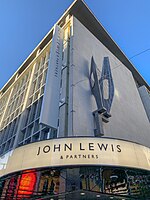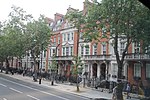Grosvenor Gardens

Grosvenor Gardens is the name given to two triangular parks in Belgravia, London, faced on their western and eastern sides by streets of the same name. Both roads run roughly north to south from Hobart Place and Grosvenor Place to Buckingham Palace Road, and is entirely the A3215. Notable buildings include the Grade II-listed Grosvenor Gardens House at Nos. 23–47, built in about 1868 by the architect Thomas Cundy III in the French Renaissance style.The Rifle Brigade War Memorial commemorates the service of the Rifle Brigade in the First and Second World Wars. It stands at the junction of Grosvenor Gardens and Hobart Place, on land donated by the 2nd Duke of Westminster. The shell-covered huts in the southern garden were part of a redesign of the park by Jean Moreux, architect-in-chief of the National Monuments and Palaces of France, in 1952. The fabrique style buildings are covered with shells from England and France, and are used to store gardening equipment.The northern garden contains the sculpture Lioness and Lesser Kudu by Jonathan Kenworthy, installed in 2000.
Excerpt from the Wikipedia article Grosvenor Gardens (License: CC BY-SA 3.0, Authors, Images).Grosvenor Gardens
Grosvenor Gardens, City of Westminster Victoria
Geographical coordinates (GPS) Address Nearby Places Show on map
Geographical coordinates (GPS)
| Latitude | Longitude |
|---|---|
| N 51.4972 ° | E -0.1463 ° |
Address
Grosvenor Gardens
Grosvenor Gardens
SW1W 0AE City of Westminster, Victoria
England, United Kingdom
Open on Google Maps











